One message rang consistent at a cheerful dedication ceremony Thursday morning for the Kendeda Building for Innovative Sustainable Design: This is just the beginning.
“Let’s all agree that today is not the final destination — not even close,” Kendeda Fund Executive Director Dena Kimball told more than 250 gathered in the super-sustainable building’s auditorium.
Kimball’s mother, Diana Blank, who is the philanthropist behind the Kendeda Fund, conceived of the building as a model to prod a transformation of design and construction in the Southeast.
That aspiration remained front and center as project team members, students, academics and university staff, as well as construction industry and sustainability leaders, celebrated the building’s completion four years after the fund announced a $30 million grant to Georgia Tech to build the building to rigorous Living Building Challenge standards and then to operate it.
“This is not a typical project, where a philanthropist says, ‘Hey, I have an idea … please build a building and here’s a check,” recently installed Georgia Tech President Angel Cabrera told the audience.
Indeed, a portion of the grant was set aside for “leverage activities” through which Tech and project leaders have been sharing lessons learned across a region often viewed as lagging in sustainability. Kendeda contributed to those efforts with its own programs meant to spread the word about regenerative design and construction (including this web publication).
Cabrera and other speakers pledged that the “leverage” would continue.
“This is a way of turning our own campus into a lab, into a learning opportunity,” he said.
Evangelical zeal was palpable at an open house that followed the dedication, during which project leaders led tours and dozens of impromptu conversations focused on ideas that might be replicated elsewhere.
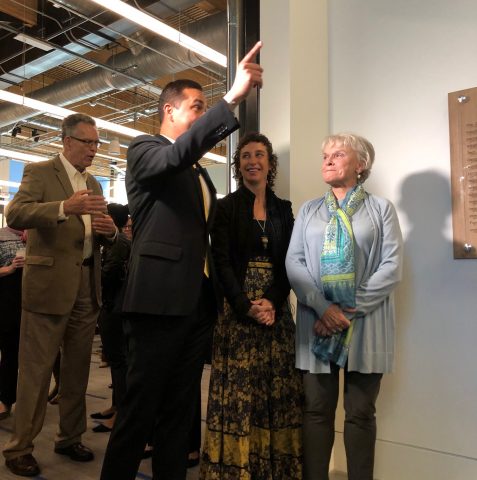
Above, Kendeda Building Director Shan Arora makes a point to the Kendeda Fund’s Kimball and Blank, with Dennis Creech, also of the Kendeda Fund, in the background. A few minutes earlier, during the dedication, Arora told the audience: “This is not the first thing that we’ve done at Georgia Tech when it comes to sustainability, and it better not be the last.”
(PHOTO AT TOP: Moments after they unveiled the Kendeda Building plaque, the Kendeda Fund’s Diana Blank and Georgia Tech President Angel Cabrera share a hug while Kendeda Fund Executive Director Dena Kimball looks on. Photo by David Brotherton.)
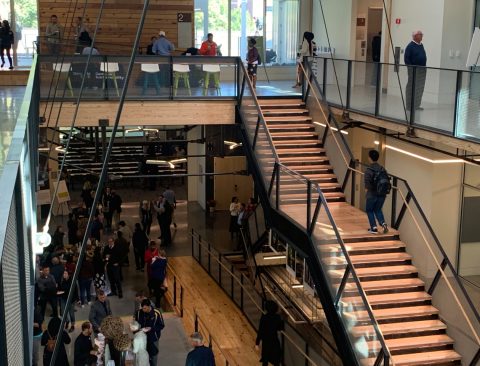
An open house after the dedication attracted Georgia Tech students, faculty members and staff members, as well as design and construction professionals, facilities managers from other schools in the region, and metro Atlanta sustainability and green building advocates. The treads on the main staircase are among a dozen salvaged materials in the building and on its grounds: They were fashioned from heart-pine joists removed from the university’s iconic Tech Tower during a renovation project.
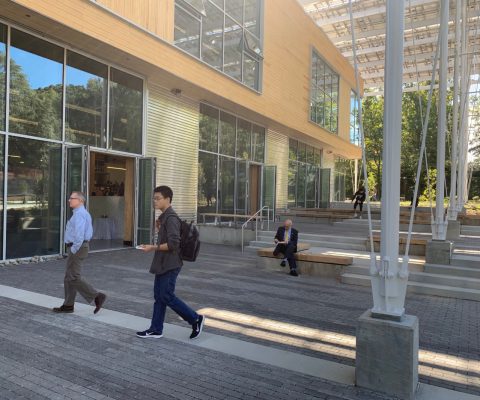
A pleasant fall day allowed three large fold-out doors to be open during the open house.Commissioning agent Darren Draper of the Epsten Group said the well-insulated building didn’t need heat the night before despite a 42-degree low, and during the day only the open windows and slow-moving Big Ass Fans were needed to keep things comfortable.
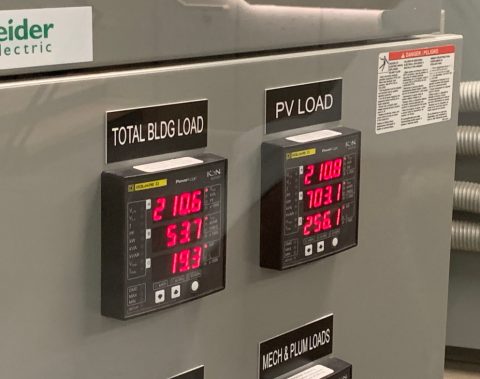
Gauges that can be viewed by any visitor through a window to the electrical control room show just how efficiently the building is operating. The middle number on the right shows that 703.1 kilowatt per hour were being generated by the building’s solar array at the moment the photograph was taken. The gauge on the right shows that the entire building —busy and heavily occupied during the event was using only 53.7 kw/h. That means some 650 kilowatts per hour were being returned to the grid at that moment. A big caveat: It was a sunny fall day. The building isn’t likely to generate 14 times the power it needs at night, on cloudy days or during summer heat and winter cold. Still, those numbers are a good indication that the Kendeda Building should be able to attain its goal of net positive energy.
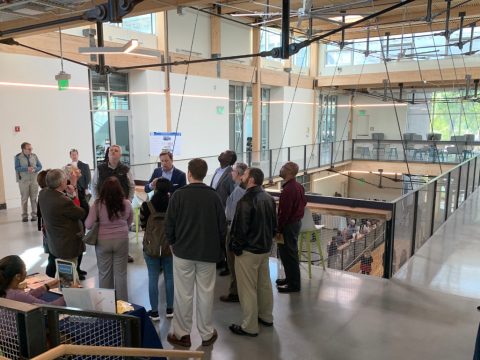
Mechanical Engineer Todd Mowinski leads one of several tours of the building Thursday. Mowinski, a partner at Newcomb & Boyd, helped to design the heating, air conditioning and ventilation system, which includes 62 fans, some of which are can be seen in the background.
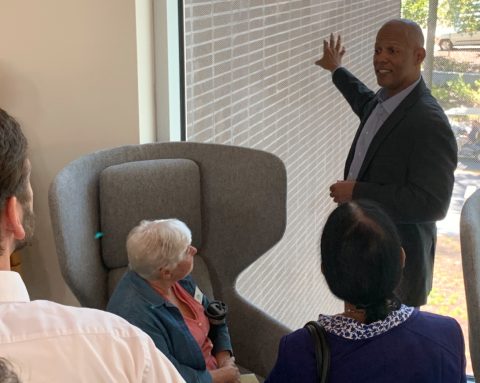
Georgia Tech Senior Project Manager John DuConge leads another tour. DuConge explained to his group how the building’s bird-safe glass is expected to reduce avian deaths — a problem that is much larger than you may realize. On behalf of the university, DuConge oversaw construction, which was led by Skanska USA.

On his tour, Lord Aeck Sargent Sustainable Design Director John Gassman took participants onto the green roof, where an outdoor classroom — complete with laboratory — effectively increases the usable space of the building. Gassman led the design team. Atlanta-based LAS and Seattle-based Miller Hull Partnership shared architectural duties as part of a conscious effort to spread Pacific Northwest familiarity with the Living Building Challenge to the Southeast.
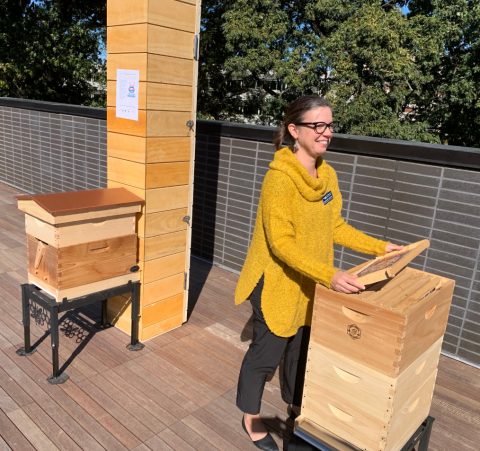
Jennifer Leavey, a Georgia Tech scientist who also runs the university’s Urban Honey Bee Project, shows off two of the hives that will be installed on the green roof, which is over the auditorium wing.
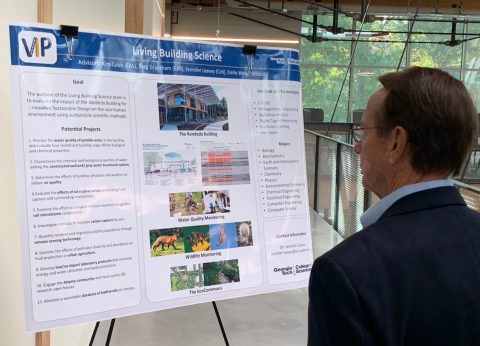
Posters throughout the open house showed off “pilot projects” that were funded by a portion of the Kendeda Fund grant.
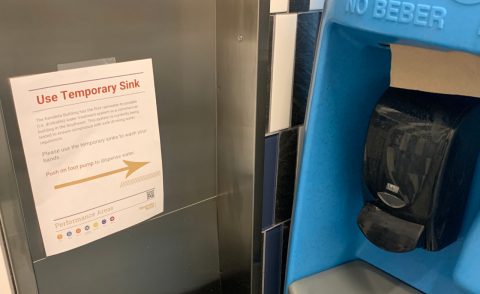
There were some concerns that the building’s potable water treatment permit wasn’t issued before the open house. Because the system must undergo 30 days of testing before the Georgia Environmental Protection Division can issue a permit, Georgia Tech had to use temporary sinks that pipe in municipal water. It turned out, however, to provide another opportunity for the university to show off the high aspirations of the Kendeda Building. DuConge is hopeful that the permit will be issued sometime this fall.


